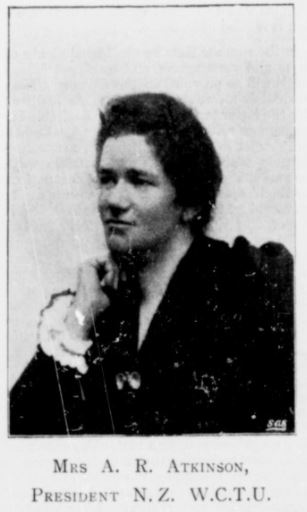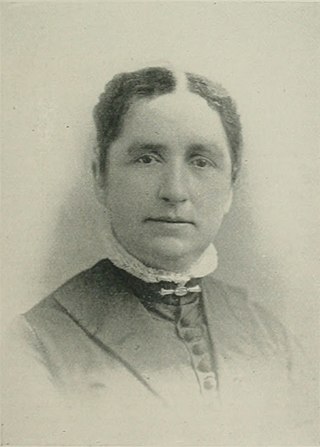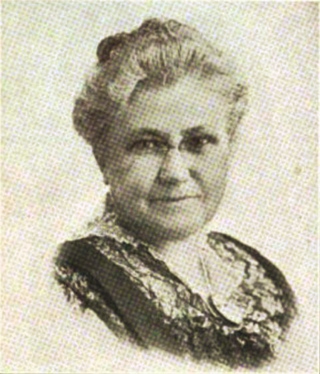The Woman's Christian Temperance Union (WCTU) is an international temperance organization. It was among the first organizations of women devoted to social reform with a program that "linked the religious and the secular through concerted and far-reaching reform strategies based on applied Christianity." It plays an influential role in the temperance movement. Originating among women in the United States Prohibition movement, the organization supported the 18th Amendment and was also influential in social reform issues that came to prominence in the progressive era.

Mary Hunt was an American activist in the United States temperance movement promoting total abstinence and prohibition of alcohol. She gained the power to accept or reject children's textbooks based on their representation of her views of the danger of alcohol. On her death there were questions asked regarding the finances of the organisation.
The Department of Scientific Temperance Instruction, the educational arm of the Woman’s Christian Temperance Union (WCTU), was an important part of the temperance movement and played a significant role in generating support for prohibition of alcohol in the U.S.

Marie Caroline Brehm was an American prohibitionist, suffragist, and politician. The Head of the suffrage department for the Woman's Christian Temperance Union (WCTU), she was a key figure in the Prohibition Party and Presbyterian Church, active in both local and national politics, and an advocate of reform laws. Twice she was appointed by the President to represent the United States at the World's Anti-Alcoholic Congress in Europe. Additionally, she was the first woman to run for the Vice President of the United States after the 19th amendment granted women the right to vote.

Martha McClellan Brown was a lecturer, educator, reformer, newspaper editor, and major leader in the temperance movement in Ohio.

Edith Jessie Archibald was a Canadian suffragist and writer who led the Maritime Women's Christian Temperance Union (WCTU), National Council of Women of Canada and the Local Council of Women of Halifax. For her many forms of social activism, she was referred to as the "Lady of Grace" by King George V, and she was designated a Person of National Historic Significance by the Government of Canada in 1997.

Annie Jane Schnackenberg was a New Zealand Wesleyan missionary, temperance and welfare worker, and suffragist. She served as president of the Auckland branch of the Women's Christian Temperance Union New Zealand 1887 to 1897, and national president for WCTU NZ from 1892 to 1901 – overseeing the final push for petitioning the government to grant women the right to vote in national elections. She also was a charter member of the National Council of Women of New Zealand.

Lily May Atkinson was a New Zealand temperance campaigner, suffragist and feminist. She served in several leadership roles at the local and national levels including Vice President of the New Zealand Alliance for Suppression and Abolition of the Liquor Traffic (1898–1921); president of Women's Christian Temperance Union New Zealand (1901–1905); and, Vice President of the National Council of Women of New Zealand (1901–1903).

In the United States, the temperance movement, which sought to curb the consumption of alcohol, had a large influence on American politics and American society in the nineteenth and twentieth centuries, culminating in the prohibition of alcohol, through the Eighteenth Amendment to the United States Constitution, from 1920 to 1933. Today, there are organizations that continue to promote the cause of temperance.
The temperance movement in India aims at curbing the use of alcohol in that country. In some places, the temperance movement has led to alcohol prohibition in India, with many temperance organisations continuing their work today.

Women's Christian Temperance Union of New Zealand is a non-partisan, non-denominational, and non-profit organization that is the oldest continuously active national organisation of women in New Zealand. The national organization began in 1885 during the visit to New Zealand by Mary Clement Leavitt, the first world missionary for the Woman's Christian Temperance Union. The WCTU NZ was an early branch of the World Woman's Christian Temperance Union and a founding affiliate of the National Council of Women of New Zealand. Men may join the WCTU NZ as honorary members.

Janette Hill Knox was an American temperance reformer, suffragist, teacher, author and editor.

Rachel Don was an accredited Methodist local preacher who became a local and national leader in the Women's Christian Temperance Union New Zealand, serving as president from 1914 to 1926. Under her leadership, the WCTU NZ focused on white slavery, promoting national prohibition, and expanding women's career opportunities, especially in the New Zealand Police Force and judicial system. She represented New Zealand at a world-wide temperance convention in London in 1920, and at the U.S. Woman's Christian Temperance Union Jubilee in 1924. She served in many other local charitable organisations, and after visiting India, became a fervent leader of the Dominion Stocking League to send refurbished clothing for impoverished children and women to Christian mission stations in India.

Nannie Webb Curtis was an American lecturer and temperance activist, widely-known as a clubwoman. She wrote essays on the topic and edited a magazine. She served as National vice-president of Woman's Christian Temperance Union (WCTU), sat on the National Executive Committee, and was also on the Official Board of the National WCTU, the lawmaking body of organization. Her father having been a Methoidist minister, she made her living lecturing as a pulpit orator on the topics of prohibition and woman suffrage on behalf of the National WCTU, Chautauqua, and the lyceum circuits. Frequently characterized as being "bigger than her state", Curtis was a patriot and a speaker of national fame.

Rosetta Lawson was an American temperance activist, educator, and suffragette. She was, with her husband, educator and activist Jesse Lawson, a co-founder of Frelinghuysen University, where she taught anatomy and physiology. She served for 30 years as a national organizer for the Woman's Christian Temperance Union. Lawson organized the first Congress of Colored Women in the United States, and was elected to the executive committee of the National Association of Colored Women's Clubs.

Anna Rankin Riggs was an American social reformer of the long nineteenth century. Active in the temperance movement, she began her work in Bloomington, Illinois, where she was one of early board of managers of The Union Signal and helped materially to lift it out of financial depression. Her principal area of activity, however, was in Portland, Oregon. Beginning in 1886, Riggs was almost continuously in office, serving as president of the Oregon Woman's Christian Temperance Union (WCTU). Having had experience in Illinois with serving on the board of managers of The Union Signal and helping to bring it out of financial depression, in 1891, she started the Oregon White Ribbon. Another prominent feature of her work in Oregon was a "school of methods" which proved an inspiration to the local WCTU unions in their department work. Eventually, she was bestowed the title of Honorary President of Oregon. Riggs also represented Oregon at conventions and was president of the International Chautauqua Association for the Pacific Northwest.

Lucia H. Faxon Additon was an American writer, music teacher, and Woman's Christian Temperance Union (WCTU) official. In addition to being a pioneer in WCTU work on the Pacific Coast, she was known as a leader in philanthropic, education, and religious work. Additon was also a clubwoman, being the founder and president of the Woman's Press Club of Oregon, and State chair of Industrial Relations in the Oregon Federation of Woman's Clubs.
Caroline M. Clark Woodward was an American temperance activist, who entered the field in 1882 as a temperance writer. She was affiliated with the Woman's Christian Temperance Union (W.C.T.U.) in Nebraska, and served as a trustee of the Woman's Temperance Temple in Chicago. Woodward received Prohibition Party nominations for Regent of the Nebraska University and for member of Congress. A forcible speaker, she conducted schools of "Methods" at Chautauqua Assemblies.

Lella A. Dillard was an American temperance leader. She served as president of the Georgia State Woman's Christian Temperance Union (W.C.T.U.), and afterwards as National Director of the W.C.T.U.'s Peace Department.

Orpha Jane "Jennie" Murray Kemp was an American temperance movement leader, writer, and newspaper circulator, nationally known for her work with the Woman's Christian Temperance Union (W.C.T.U.), and for her Food Administration campaigning during World War I. For 50 years, Kemp was an active W.C.T.U. worker. She campaigned vigorously through California and Oregon in the interests of prohibition. She served as president of the Oregon W.C.T.U. and later as secretary of the National W.C.T.U.. Kemp was editor and publisher of Our Messenger, 1889–1903; circulation manager of The Union Signal, and The Young Crusader, 1903–12; and National W.C.T.U. press superintendent since 1912.

















